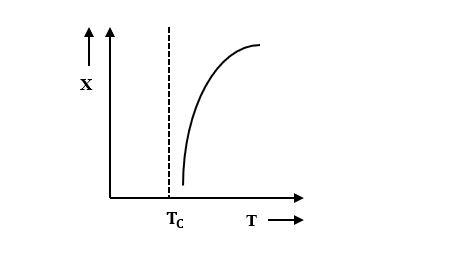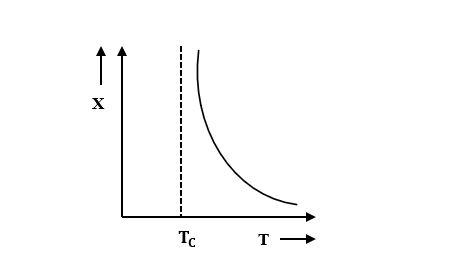
The variation of magnetic susceptibility with the temperature of a ferromagnetic material can be plotted as?
A.

B.

C.

D.





Answer
563.7k+ views
Hint: To answer this question, use the Curie-Weiss law, which gives the relationship between magnetic susceptibility, Curie temperature and the absolute temperature. This relationship shows that as the temperature increases, magnetic susceptibility decreases but it does not decrease linearly. Use this information to find the variation in magnetic susceptibility with temperature.
Formula used:
$\chi= \dfrac {C}{T- {T}_{C}}$
Complete step by step answer:
The magnetic susceptibility of a ferromagnetic material in paramagnetic region is given by,
$\chi= \dfrac {C}{T- {T}_{C}}$ …(1)
Where, $\chi$ is the magnetic susceptibility of a material
C is the material-specific Curie constant
T is the absolute temperature measured in Kelvin
${T}_{C}$ is the Curie temperature measured in Kelvin
From the equation. (1), it can be inferred that $\chi$ is inversely proportional to the absolute temperature. This implies as the temperature increases magnetic susceptibility of the material decreases. But it does not decrease linearly. It shows a rectangular hyperbola-like relation. Thus, magnetic $\chi$ vs T forms a hyperbola graph. The law predicts a singularity in the susceptibility at $T={T}_{C}$.
So, the correct answer is “Option B”.
Note:
Students must remember that the diamagnetic materials have negative susceptibility i.e. $\chi < 0$. Whereas the paramagnetic, superparamagnetic and ferromagnetic materials have positive susceptibilities i.e. $\chi > 0$. The temperature above ${T}_{c}$ a ferromagnetic material becomes paramagnetic. Below the Curie temperature, the dipoles of a ferromagnetic material are ordered whereas above the Curie temperature, the dipoles are disordered. Students must keep in mind that the ferromagnetic materials such as iron and cobalt do not have constant susceptibilities. For a diamagnetic material, the magnetic susceptibility is independent of the temperature.
Formula used:
$\chi= \dfrac {C}{T- {T}_{C}}$
Complete step by step answer:
The magnetic susceptibility of a ferromagnetic material in paramagnetic region is given by,
$\chi= \dfrac {C}{T- {T}_{C}}$ …(1)
Where, $\chi$ is the magnetic susceptibility of a material
C is the material-specific Curie constant
T is the absolute temperature measured in Kelvin
${T}_{C}$ is the Curie temperature measured in Kelvin
From the equation. (1), it can be inferred that $\chi$ is inversely proportional to the absolute temperature. This implies as the temperature increases magnetic susceptibility of the material decreases. But it does not decrease linearly. It shows a rectangular hyperbola-like relation. Thus, magnetic $\chi$ vs T forms a hyperbola graph. The law predicts a singularity in the susceptibility at $T={T}_{C}$.
So, the correct answer is “Option B”.
Note:
Students must remember that the diamagnetic materials have negative susceptibility i.e. $\chi < 0$. Whereas the paramagnetic, superparamagnetic and ferromagnetic materials have positive susceptibilities i.e. $\chi > 0$. The temperature above ${T}_{c}$ a ferromagnetic material becomes paramagnetic. Below the Curie temperature, the dipoles of a ferromagnetic material are ordered whereas above the Curie temperature, the dipoles are disordered. Students must keep in mind that the ferromagnetic materials such as iron and cobalt do not have constant susceptibilities. For a diamagnetic material, the magnetic susceptibility is independent of the temperature.
Recently Updated Pages
Master Class 12 Business Studies: Engaging Questions & Answers for Success

Master Class 12 Economics: Engaging Questions & Answers for Success

Master Class 12 English: Engaging Questions & Answers for Success

Master Class 12 Maths: Engaging Questions & Answers for Success

Master Class 12 Social Science: Engaging Questions & Answers for Success

Master Class 12 Chemistry: Engaging Questions & Answers for Success

Trending doubts
What are the major means of transport Explain each class 12 social science CBSE

Which are the Top 10 Largest Countries of the World?

Draw a labelled sketch of the human eye class 12 physics CBSE

Explain sex determination in humans with line diag class 12 biology CBSE

The pH of the pancreatic juice is A 64 B 86 C 120 D class 12 biology CBSE

Explain sex determination in humans with the help of class 12 biology CBSE




